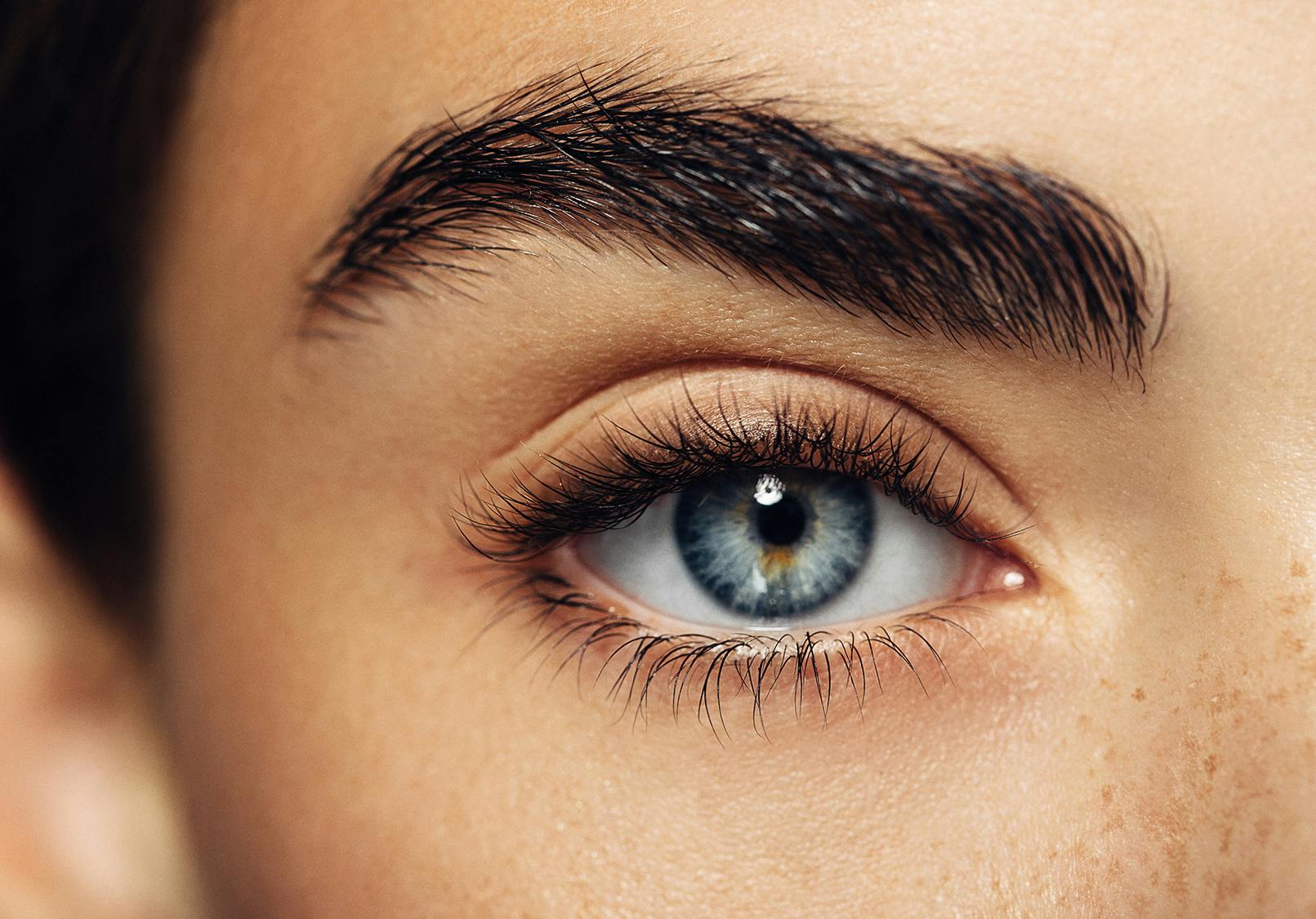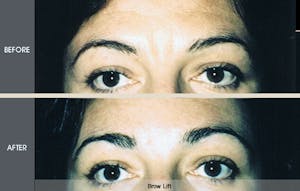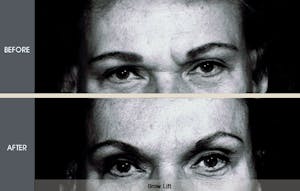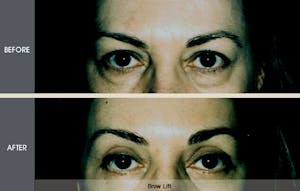Forehead / Brow Lift
Top New York plastic surgeon Dr. Darrick Antell is board certified in plastic surgery, emphasizing aesthetic and cosmetic surgery. One of the procedures he performs is the forehead lift, also known as a brow lift.
A forehead lift corrects drooping brows and improves the horizontal lines and furrows on the forehead that can make a person appear older, angry, sad, or tired. If you are considering a brow lift, this page will give you a complete understanding of what to expect.
Considering a Forehead Lift
A forehead lift or brow lift is a procedure that restores a more youthful, refreshed look to the area above the eyes: Correcting drooping brows and improving the horizontal lines and furrows that can make a person appear aged, angry, sad, or tired.
In a forehead lift, the muscles and tissues that cause the furrowing or drooping are altered to smooth the forehead, raise the eyebrows and minimize frown lines. Dr. Antell may use the conventional surgical method, in which the incision is hidden just behind the hairline, or it may be performed with the use of an endoscope, a viewing instrument that allows the procedure to be performed with minimal incisions. Both techniques yield similar results — smoother forehead skin and a more youthful, animated appearance.

Exactly how a brow lift is done and how dramatic its results depend on the concerns and conditions that a patient presents with. Chances are, with the expertise and experience of Dr. Antell, your cosmetic goals can be met, leaving you with a naturally presenting and more youthful forehead, adding vibrancy and life to your whole face.
The best candidates for Forehead Lift Surgery
A forehead lift is most commonly performed in the 40-60 age range to minimize the visible effects of aging. However, it can also help people of much younger ages who have developed furrows or frown lines due to stress or muscle movement over time. Patients with inherited conditions such as a low, heavy brow or furrowed lines above the nose can achieve a more alert and refreshed look with a brow lift.
The forehead lift is often performed in conjunction with a facelift to provide a smoother overall look to the face. Eyelid surgery (blepharoplasty) may also be performed at the same time, particularly if a patient has significant skin overhang in the upper eyelids. Sometimes patients who believe they need upper-eyelid surgery find that a forehead lift better meets their surgical goals.
Patients who are bald, who have a receding hairline, or who have had previous upper-eyelid surgery may still be good candidates for forehead lift. Dr. Antell will simply alter the incision location or perform a more conservative operation.
A forehead lift can enhance your appearance and your self-confidence, but it won't always change your looks entirely. Before deciding to have the surgery, think carefully about your expectations and discuss them in detail with your doctor.
All Plastic Surgery carries some uncertainty and risk
Complications are rare and usually minor when a forehead lift is performed by a qualified plastic surgeon. Yet, the possibility of complications must be considered. You can reduce your risk of complications by closely following your surgeon's instructions both before and after surgery.
Planning your Forehead Lift Surgery
For a better understanding of how a forehead lift might change your appearance, look into a mirror and place the palms of your hands at the outer edges of your eyes, above your eyebrows. Gently draw the skin up to raise the brow and the forehead area. That is approximately what a forehead lift would do for you. When you consult a plastic surgeon, he or she will first evaluate your face, including the skin and underlying bone structure.
During your consultation, the surgeon will discuss your goals for the surgery and ask you about certain medical conditions that could cause problems during or after the procedure, such as uncontrolled high blood pressure, blood-clotting problems, or the tendency to develop large scars. Be sure to tell the surgeon if you have had previous facial surgery, if you smoke or take any drugs or medications — including aspirin or other drugs that may affect healthy blood clotting.
Your surgeon will explain the surgical technique, the recommended type of anesthesia, the type of facility where the surgery will be performed and the risks and costs involved. Feel free to ask any and all questions you may have.
Preparing for your Forehead Lift Surgery
Your surgeon will give you specific instructions to prepare for the procedure, including guidelines on eating and drinking, smoking, and taking or avoiding certain vitamins and medications. Carefully following these instructions will help your surgery and your recovery proceed smoothly.
Whether your forehead lift is done in an outpatient facility or in the hospital, it’s best to arrange for someone to drive you home after your surgery, and to help you out for a day or two around the house as possible.

Anesthesia used for Forehead Lift Surgery
Most forehead lifts are performed under local anesthesia, combined with a sedative to make you drowsy. You'll be awake but relaxed, and although you may feel some tugging and mild discomfort, your forehead will be insensitive to pain. General anesthesia is also an option, in which case you'll sleep through the entire operation.
Where your Forehead Lift Surgery will be performed
Most of Dr. Antell’s surgeries are done in his private state-of-the-art and accredited surgical facility in New York. This allows for the highest possible safety, hygiene, and comfort of patients and allows patients the benefit of reduced hospital fees.
The Forehead Lift Surgery
Dr. Antell will help you decide which surgical approach will best achieve your cosmetic goals: the classic or "open" method, or the endoscopic forehead lift method. In your personal consultation, you’ll understand the recommended technique and why your surgeon feels it suits you best.
Classic Forehead Lift
In the classic forehead lift, a coronal incision will be used, following a headphone-like pattern, starting at about ear level and running across the top of the forehead and down the other side of the head. The incision is usually made well behind the hairline so that the scar won't be visible. Working through the incision, the skin of the forehead is carefully lifted so that the underlying tissue can be removed and the muscles of the forehead can be altered or released. The eyebrows may also be elevated and excess skin at the incision point will be trimmed away to help create a smoother, more youthful appearance. The incision is then closed with stitches or clips. Your face and hair will be washed to prevent irritation and the rubber bands will be removed from your hair. Although some plastic surgeons use no dressings, Dr. Antell may choose to cover the incision with gauze padding and wrap the head in an elastic bandage.
Endoscopic Forehead Lift
In the endoscopic forehead lift, your surgeon will make three to five short scalp incisions, each less than an inch in length. An endoscope, which is a pencil-like camera device connected to a television monitor, is inserted through one of the incisions, allowing the surgeon to have a clear view of the muscles and tissues beneath the skin. Using another instrument inserted through a different incision, the forehead skin is lifted and the muscles and underlying tissues are removed or altered to produce a smoother appearance. The eyebrows may also be lifted and secured into their higher position by sutures beneath the skin's surface or by temporary fixation screws placed behind the hairline.
When the lift is complete, the scalp incisions will be closed with stitches or clips and the area will be washed. Gauze and an elastic bandage will be placed at the close of the procedure.
Your new look after Forehead Lift Surgery
Most patients are pleased with the results of a forehead lift, no matter which surgical method is used. Often, patients don't realize how much their sagging forehead contributed to the signs of aging until they see how much younger and more rested they appear after the lift.
Although a forehead lift does not stop the clock, it can minimize the appearance of aging for years. As time passes, you may want to repeat the procedure.
After your Forehead Lift Surgery
The immediate post-operative experience for a patient who has had a classic forehead lift may differ significantly from a patient who had the procedure performed endoscopically.
Classic forehead lift patients may experience some numbness and temporary discomfort around the incision, which can be controlled with prescription medication. Patients who are prone to headaches may be treated with an additional longer-acting local anesthesia during surgery as a preventive measure.
It’s best to keep your head elevated for two to three days following surgery to minimize swelling and assist in healing. Swelling may also affect the cheeks and eyes; however, this should begin to disappear in a week or so.
As the nerves heal, numbness on the top of your scalp may be replaced by itching. If bandages were used, they will be removed a day or two after surgery. Most stitches or clips will be removed within two weeks, sometimes in two stages.
Endoscopic forehead lift patients may experience some numbness, incision discomfort, and mild swelling. Incision site pain is usually minimal, but can be controlled with medication, if necessary. Endoscopic forehead lift patients usually experience less of the itching sensation felt by patients who have had the classic forehead lift. The stitches or staples used to close the incisions are usually removed within a week and the temporary fixation screws within two weeks.
Getting back to normal after Forehead Lift Surgery
Although you should be up and about in a day or two, plan on taking it easy for at least the first week after surgery. You should be able to shower and shampoo your hair within two days, or as soon as the bandage is removed.
Most patients are back to work or school in a week to 10 days. Endoscopic patients may feel ready to return even sooner. Vigorous physical activity should be limited for several weeks, including jogging, bending, heavy housework, sex, or any activity that increases your blood pressure. Prolonged exposure to heat or sun should be limited for several months.
Most of the visible signs of surgery should fade completely within about three weeks. Minor swelling and bruising can be concealed with makeup. You may feel a bit tired at first, but your energy level will increase as you begin to look and feel better.
"Always Excellent…lovely, professional staff as well!"
Darrick E. Antell, MD, Brow Lift Specialist
Dr. Darrick E. Antell is among the world’s most celebrated cosmetic surgeons. Operating out of his private, state-of-the-art facility, he and his professional team bring the best in care and results to a wide patient base from across New York. Please call for a private consultation or schedule an appointment online at our office.






